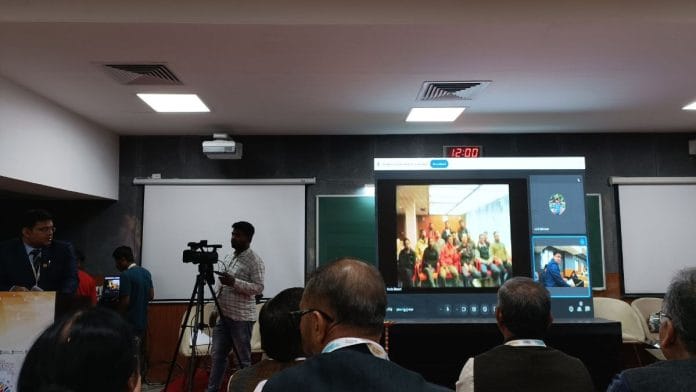Guwahati: A small lecture hall on the third floor of IIT-Guwahati’s academic complex received a special Zoom call from 22 researchers at India’s Bharati station in Antarctica. The meteorologists, engineers, and scientists from various Indian organisations gathered in -10℃ weather to speak to Assamese school students about pursuing a research career in the Antarctic.
“How do we know you’re really speaking from Antarctica?” asked an audience member attending the video conference at the India International Science Festival. In response, the scientists panned their camera to the right, showing the bright white expanse through their station’s window.
“It must be summer there now, where it is light for days on end, and you can actually reach Antarctica safely by ship or plane,” said Dr Rahul Mohan, a scientist at the National Centre for Polar and Ocean Research (NCPOR) and one of the hosts moderating the video conference from Guwahati.
“The real problem is in winters – we have a running joke that when the vodka bottle freezes, that’s when you know you’re in trouble,” he said, laughing.
India’s research work in Antarctica
From the study of sea ice to microbes and viruses and analysing the geological history of the windiest, driest and coldest continent, India’s research work in Antarctica spans several areas.
It also isn’t confined to the NCPOR. Antarctica’s Indian contingents have scientists from the Indian Meteorological Department (IMD), the Indian Space Research Organisation (ISRO), and the Indian Institute of Geomagnetism (IIGM). What united them all, said Mahesh BS, one of the NCPOR scientists speaking from Antarctica, was their love for exploring the “wild continent.”
The session was hosted by the NCPOR, which is managed by the Union Ministry of Earth Sciences. It is responsible for all the missions and expeditions that India sends to Antarctica to its two stations Maitri and Bharati. The country’s first station in Antarctica, called Dakshin Gangotri, was built in 1983, which later sank in the snow in 1990. However, India built the Maitri station in 1989 and the Bharati station in 2012.
The year 1983 was also significant because India joined the Antarctic Treaty – an international pact initially signed by 12 countries on 1 December 1959 to cooperate and conduct peaceful research in Antarctica. Today, the treaty has 57 signatories.
For students and visitors, it was a double delight. Many NCPOR members who had previously been to Antarctica were also present at the Guwahati festival. Whenever the video conference lagged, as it often did due to poor connectivity, NCPOR director Dr Thamban Meloth and scientist Rahul Mohan filled in the gaps with their polar experience.
“To understand any biological process in the world, especially climate change, you must understand Antarctica,” said Dr Meloth, recalling the importance of the multiple international missions to study the continent.
Also read:
Food, work, and play in Antarctica
Student attendees from Kendriya Vidyalaya and other schools in Guwahati and nearby districts lined up to ask questions. They wanted to know when the scientists woke up, what they ate, and how they spent their free time on the station.
“Do you not get bored down there?” asked one curious student.
The team, which has been stationed there since early November, described their routine in detail – how they wake up at 6 AM, help the chef prepare food, and clean their lounge areas, toilets, machines, and more. Then, each researcher returns to their work, which may include daily weather monitoring or fieldwork that involves collecting ice and biodiversity samples.
The Bharati station is the newest NCPOR station, which contains everything from lounge areas to a sauna to separate workstations for the multiple organisations that send their scientists there. Researchers in Antarctica get food shipments from planes and ships during the summer, and have cold storage facilities to preserve it all.
“Do you ever meet penguins and other animals?” asked 12-year-old Jagat in Assamese. Scientist Rivertis Pariong from Meghalaya, who was part of the Antarctica contingent, translated the question for his colleagues.
“We often come across Adelie penguins near our research stations”, said Mahesh in response. “They’re extremely friendly but we’re not allowed to interact with them. Antarctica is as yet one of the most pristine, untouched landscapes in the world, and so is its wildlife. We’re not allowed to disturb that,” he added.
The more scientifically curious among the students wanted to know India’s role and relationship with Antarctica, and what the numerous researchers there were working on. Imagine their surprise when Dr Mohan introduced the NCPOR scientists’ latest project: Similarities between the Eastern Ghats and Antarctica.
“Did you know that India and Antarctica were part of the same gigantic piece of rock millions of years ago?” said Mohan while addressing students. “We’re trying to find out if our Eastern Ghats in India are geologically similar to Antarctica’s southeastern region.”
Geography student Ankit from Odisha had two simple questions for the scientists. First, he asked how he could pursue a career as a researcher in Antarctica. The scientists advised him to finish his Master’s degree in geographical sciences and subsequently reach out to NCPOR for PhD opportunities. After his query was resolved, Ankit proceeded with a special request for Mahesh and the contingent.
“Could you please say my village Boradi’s name? It would be the first time anyone in Antarctica ever said it.” Twelve thousand km away, 22 Indian scientists enthusiastically waved hello to the little village in Odisha.
(Edited by Zoya Bhatti)






